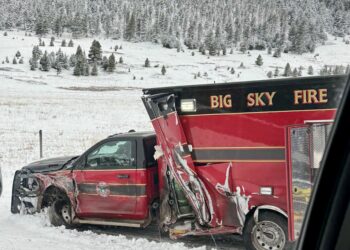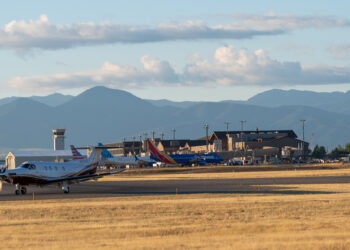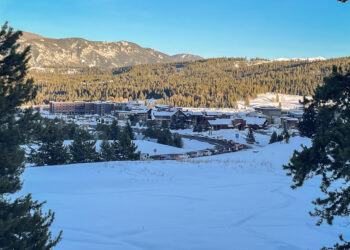Study looks at elk behavior
By Jessianne Castle EBS ENVIRONMENTAL & OUTDOORS EDITOR
BOZEMAN – Hike through the mountains in Montana and you’re increasingly likely these days to see the red hues of dying forests. In some places, the pine trees have long since shed their dry needles, their arthritic limbs merely ghosts of the mountains.
The cause of this decline in forest health—with implications for lodgepole and whitebark pine, to name a few species—is largely the result of the native mountain pine beetle. And as forests change from dense and green to bare, open stands, wildlife is taking note.
According to a study conducted by biologists with Montana Fish, Wildlife and Parks, elk in the beetle-killed Elkhorn Mountains south of Helena are changing their use of the forest. While a change in habitat from beetle infestation appears to be only one component of the way elk use the landscape, a study released in August indicates that elk use the dying forests less in the summer and fall.
Researchers say an elk’s use of the forest is largely related to cover and security needs, and various forest types provide a range of overall canopy cover and protection from predators and human hunters. While stands of dead lodgepole pine have more cover than healthy Douglas fir and ponderosa pine forests, the infected lodgepole remain less secure for elk than their healthy counterparts.
For the Elkhorn study, biologists radio collared 60 elk and followed their movements over the course of four years; they found that elk are using public land less now than during a study conducted in the 1980s, prior to beetle infestation. The phenomenon might be attributable to the differences in hunting pressures between public and private land, and the lack of adequate security on public land due to dying trees.
A large portion of the study area included the Elkhorn Wildlife Management Unit, which is the only U.S. Forest Service wildlife management unit in the country. FWP manages the area for hunting and releases a limited number of cow and young, spike bull elk tags, and the department also offers permits for larger bulls, which is the most difficult elk permit to draw in the state.
In an FWP press release announcing the completion of the study, FWP supervisor Mark Deleray said elk management is complicated in Montana.
“It always involves public hunters, private landowners, various land management agencies and changing habitat conditions,” he said. “This study gives us important information on habitat and the needed security to help keep elk on public lands during the hunting seasons.”
Overall, according to the release, the new findings will inform future land management, “to provide adequate security for cow and bull elk during the hunting seasons and discourage elk redistributions to private lands. Similar to many areas in Montana, private land surrounding public land can be a beacon to elk when the hunting pressure increases on public lands.”
“The places in Montana with the worst beetle kill are places with thick lodgepole forests that are conducive to infestation,” FWP research biologist Kelly Proffitt said in an email to EBS. “We have been actively conducting research about elk security in Montana for several years … This is a big issue well beyond the Elkhorns.”
She added that FWP wants to better understand the overall health of our public lands and how to keep elk on public land rather than see them redistribute to private properties. Proffitt said as FWP learns more about elk movement, the department can work with the Forest Service and Bureau of Land Management in how to better manage public lands for wildlife.
As one example, Proffitt described a research project on beetle-kill in the Sapphire Mountains south of Missoula. After the Forest Service modified travel in that portion of the forest, they saw an increase in elk security by 30 percent.
While FWP is actively researching the larger impacts of mountain pine beetle, scientists have been studying the bug itself for a number of decades. The mountain pine beetle bores into the bark of healthy trees in order to lay its eggs, and once hatched, the larva feed on the host tree, eventually girdling and killing the tree. The mountain pine beetle is one of an estimated 600 different bark beetle species in the U.S.
In recent decades, the prevalence of mountain pine beetle is continuing to increase across the Western U.S.
According to Jesse Logan, the former project leader for the Forest Service’s Interior West Bark Beetle Project, mountain pine beetle populations appear to be under the direct influence of seasonal temperature. Logan, who retired in 2006, found that as trending temperatures rise, pine beetles are able to survive through the winters and at higher elevations; a warming climate is giving these tree-killers the perfect setting for extensive outbreaks.
Logan notes, however, that while beetles have seemingly devastating impacts on our forests, in large part they serve a natural process for lodgepole: beetle-killed lodgepole forests fuel wildfires that lead to tree regeneration decades later.
But Logan’s sentiment flips when the conversation turns to the question of whitebark pine, a high-alpine tree species that has come under beetle attack due to climate change. In an article published in 2004 by “High Country News,” Logan told the reporter, “When I see outbreaks intensify in the lodgepole pine, it’s an interesting ecological event. When I see a 700-year-old whitebark pine go down, I have a completely different reaction. It breaks my heart.”













